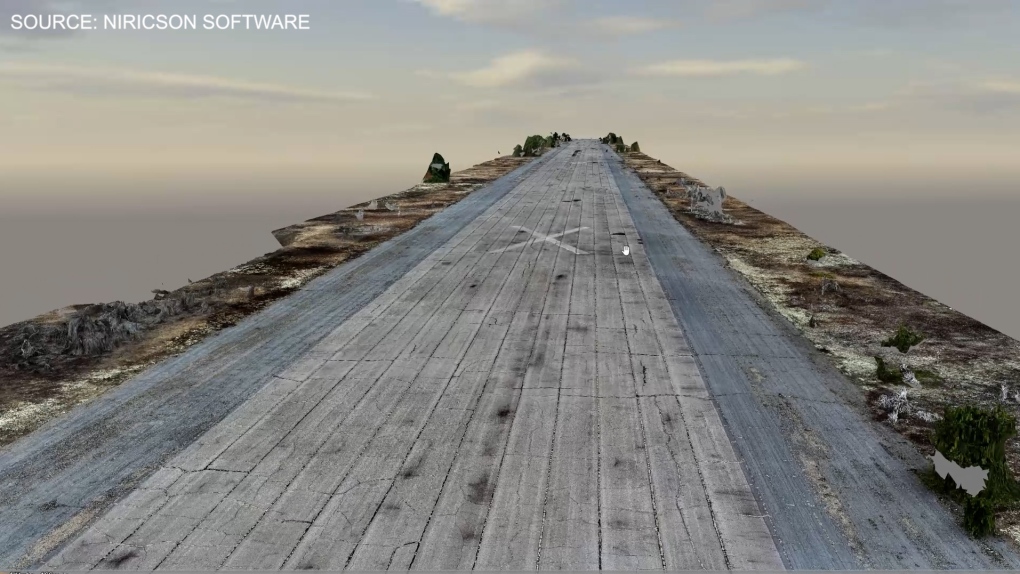Pearson Airport tries out runway inspections powered by drones and AI
There was something unusual in the skies above the runways at Pearson International Airport this week — not a plane, but a drone.
It’s a trial run of a new technology designed to use AI to speed up runway inspections with an eye to allowing Canada’s busiest airport to get even busier.
- Download our app to get local alerts to your device
- Get the latest local updates right to your inbox
For about five hours on Monday, a crew with Victoria, B.C.-based Niricson Software huddled over a laptop tracking the drone as its camera took high resolution photos of the asphalt.
“We’re looking for cracking and spalling and anything that would give a sense of the integrity of the surface,” said Dean Arscott, the company’s UAV operations lead, in an interview off runway 15R/33L.
The camera’s images are then fed into a machine-learning algorithm that can identify any defects and build them into a detailed 3D model of the runway.
The advantage, said Arscott, is that crews manually inspecting it take longer and don’t build any digital records.
“Instead of taking the entire day to do this runway, we can do this in a few hours, and that means less time for the runway, more money for the airport,” Arscott said.
Runway condition is a serious issue for airports, who must keep their runways smooth as any stray objects can damage airplanes when they take off or land.
“This is a trial to see if this is something that could be the future of how we do these inspections,” said Tori Gass, a Greater Toronto Airports Authority spokesperson.
“This could really revolutionize the way we do inspections,” she said.
The project is funded by Transport Canada, said Arscott. The technology was tested out on an unused airport near Killaloe, Ont. and has also examined other infrastructure in B.C. including hydro dams.
 The 3D model of an unused airport near Killaloe, Ontario created by Niricson Software (supplied).
The 3D model of an unused airport near Killaloe, Ontario created by Niricson Software (supplied).
“On one dam we identified over a million cracks. This would have taken a human working every hour of the day for two years straight to do themselves,” said Arscott.
If it works, he said he hopes the technology takes off.
“We could do every airport in the world,” he said. “We have big vision at our company.”
CTVNews.ca Top Stories

Young people 'tortured' if stolen vehicle operations fail, Montreal police tell MPs
One day after a Montreal police officer fired gunshots at a suspect in a stolen vehicle, senior officers were telling parliamentarians that organized crime groups are recruiting people as young as 15 in the city to steal cars so that they can be shipped overseas.
'It was joy': Trapped B.C. orca calf eats seal meat, putting rescue on hold
A rescue operation for an orca calf trapped in a remote tidal lagoon off Vancouver Island has been put on hold after it started eating seal meat thrown in the water for what is believed to be the first time.
Man sets self on fire outside New York court where Trump trial underway
A man set himself on fire on Friday outside the New York courthouse where Donald Trump's historic hush-money trial was taking place as jury selection wrapped up, but officials said he did not appear to have been targeting Trump.
Sask. father found guilty of withholding daughter to prevent her from getting COVID-19 vaccine
Michael Gordon Jackson, a Saskatchewan man accused of abducting his daughter to prevent her from getting a COVID-19 vaccine, has been found guilty for contravention of a custody order.
Mandisa, Grammy award-winning 'American Idol' alum, dead at 47
Soulful gospel artist Mandisa, a Grammy-winning singer who got her start as a contestant on 'American Idol' in 2006, has died, according to a statement on her verified social media. She was 47.
She set out to find a husband in a year. Then she matched with a guy on a dating app on the other side of the world
Scottish comedian Samantha Hannah was working on a comedy show about finding a husband when Toby Hunter came into her life. What happened next surprised them both.
B.C. judge orders shared dog custody for exes who both 'clearly love Stella'
In a first-of-its-kind ruling, a B.C. judge has awarded a former couple joint custody of their dog.
Saskatoon police to search landfill for remains of woman missing since 2020
Saskatoon police say they will begin searching the city’s landfill for the remains of Mackenzie Lee Trottier, who has been missing for more than three years.
Shivering for health: The myths and truths of ice baths explained
In a climate of social media-endorsed wellness rituals, plunging into cold water has promised to aid muscle recovery, enhance mental health and support immune system function. But the evidence of such benefits sits on thin ice, according to researchers.
































